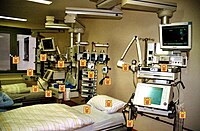
Photo from wikipedia
Handwashing sinks and their associated premise plumbing are an ideal environment for pathogen-harboring biofilms to grow and spread throughout facilities due to the connected system of wastewater plumbing. This study… Click to show full abstract
Handwashing sinks and their associated premise plumbing are an ideal environment for pathogen-harboring biofilms to grow and spread throughout facilities due to the connected system of wastewater plumbing. This study was designed to understand the distribution of pathogens and antibiotic resistant organisms (ARO) within and among handwashing sinks in healthcare settings, using culture-dependent methods to quantify Pseudomonas aeruginosa , opportunistic pathogens capable of growth on a cefotaxime-containing medium (OPP-C), and carbapenem-resistant Enterobacteriaceae (CRE). Isolates from each medium identified as P. aeruginosa or Enterobacteriaceae were tested for susceptibility to aztreonam, ceftazidime, and meropenem; Enterobacteriaceae were also tested against ertapenem and cefotaxime. Isolates exhibiting resistance or intermediate resistance were designated ARO. Pathogens were quantified at different locations within handwashing sinks and compared in quantity and distribution between healthcare personnel (HCP) and patient room (PR) sinks. ARO were compared between samples within a sink (biofilm vs planktonic samples) and between sink types (HCP vs. PR). The drain cover was identified as a reservoir within multiple sinks that was often colonized by pathogens despite daily sink cleaning. P. aeruginosa and OPP-C mean log 10 CFU/cm 2 counts were higher in p-trap and tail pipe biofilm samples from HCP compared to PR sinks (2.77 ± 2.39 vs. 1.23 ± 1.62 and 5.27 ± 1.10 vs. 4.74 ± 1.06) for P. aeruginosa and OPP-C, respectively. P. aeruginosa and OPP-C mean log 10 CFU/ml counts were also higher (p < 0.05) in HCP compared to PR sinks p-trap water (2.21 ± 1.52 vs. 0.89 ± 1.44 and 3.87 ± 0.78 vs. 3.21 ± 1.11) for P. aeruginosa and OPP-C, respectively. However, a greater percentage of ARO were recovered from PR sinks compared to HCP sinks (p < 0.05) for Enterobacteriaceae (76.4 vs. 32.9%) and P. aeruginosa (25.6 vs. 0.3%). This study supports previous work citing that handwashing sinks are reservoirs for pathogens and ARO and identifies differences in pathogen and ARO quantities between HCP and PR sinks, despite the interconnected premise plumbing.
Journal Title: Scientific Reports
Year Published: 2020
Link to full text (if available)
Share on Social Media: Sign Up to like & get
recommendations!